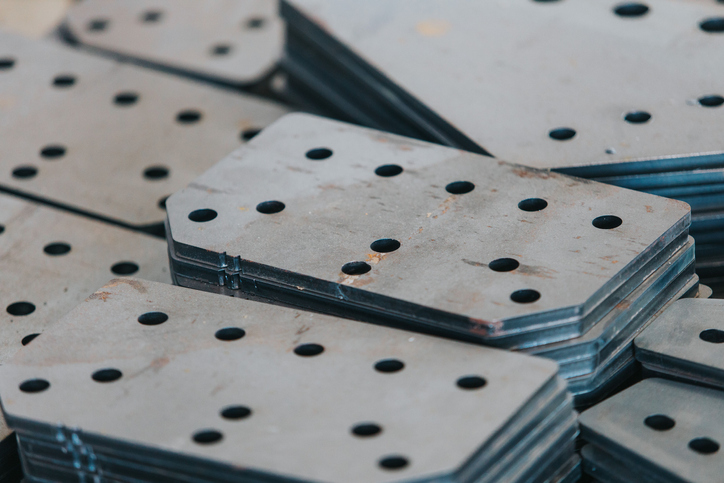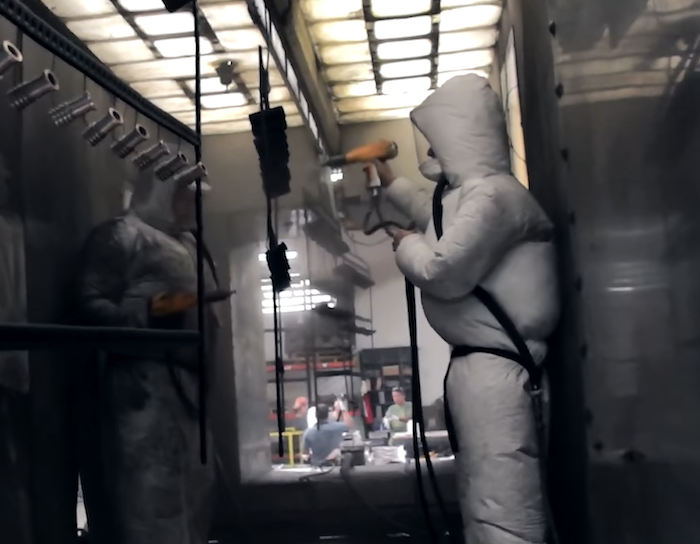E-coating, or electrocoating, is a popular method for applying a protective and decorative finish to aluminum surfaces. Although its origin is in the automotive industry, its application cuts across all aspects of manufacturing due to its benefits. In this article, we delve into the e-coating process for aluminum, its advantages, key applications, and other aluminum coating types.

E-Coating Process
Generally, e-coating entails applying a uniform coating to metal parts using charged paint particles. In this process, the particles bond to the metal surface through electrophoresis, resulting in a uniform film on the surface. The process follows several steps, each critical to achieving a high-quality finish.
Surface Preparation
Before applying the paint, it is necessary to work on the aluminum surface following these steps:
- Cleaning: Remove dirt, grease, oils, and all other contaminants from the metal surface. Alkaline cleaners are especially useful in the cleaning process.
- Rinsing: After cleaning, rinse the surface thoroughly with water to remove any residual cleaning agents or contaminants. It is advisable to use demineralized water throughout this process.
- Etching: An etching solution removes oxides and creates a slightly rough surface to improve paint adhesion.
- Rinsing and Neutralizing: Again, rinse the surface and neutralize using water.
Priming
After cleaning, the surface is further prepared for e-coating by applying a conversion coating like chromate or phosphate. These coatings enhance corrosion resistance and improve the adhesion of the e-coat. After this step, it is also necessary to rinse and dry the surface.
Coating
The actual e-coating of the aluminum part entails:
- Bath Preparation: The e-coating bath contains a water-based solution with dispersed paint particles and resins. This step is critical because the concentration of the paint, pH, and conductivity requires careful control to ensure uniform deposition.
- Submersion and Electroplating: Submerge the aluminum part in the bath and apply a set electric current. This causes the paint particles to migrate to the aluminum surface, which acts as an electrode.
- Thickness Control: Control the coating thickness by adjusting the voltage and time the part spends in the bath.

Post-Rinsing and Curing
After e-coating, remove the excess paint on the aluminum using water and/or chemical solutions, ensuring a smooth and uniform finish. An environmentally friendly approach is recirculating and filtering the rinse water to recover and reuse paint particles. Then, bake the aluminum part in an over to cure the paint, forming a hard, durable finish. Moreover, the temperature and time of baking depend on the specific coating formulation.
Benefits of E-Coating Aluminum
E-coating aluminum parts has several benefits, which is why it is common in several industries. The following sections highlight some of these advantages.
Uniform Coverage
E-coating provides a uniform and consistent coating thickness across the entire surface, including hard-to-reach areas, edges, and complex geometries. Compared to other coating methods, it is also less likely to have defects like runs, sags, and drips.
Consistency and Repeatability
Due to automation, this coating method ensures consistent quality across multiple production runs. It also enables precise control of process parameters, which helps ensure repeatable and reliable results.
Enhanced Corrosion Resistance
This process entails the formation of a robust barrier that protects aluminum from oxidation and environmental factors, thus increasing the component’s lifespan and making it suitable for harsh environments.
Excellent Adhesion
The electrocoating process creates a strong bond between the aluminum surface and the coating.
Aesthetic Appeal
E-coating provides a smooth, high-quality finish with color consistency across large batches of parts.
Environmental Benefits
Water-based solutions make it a better option for coating processes involving solvent-based coatings.
Cost Effectiveness
Compared with most coating methods, e-coating offers lower labor costs, longer protection, and high material efficiency.
Versatility
Although e-coating is commonly used on aluminum components, it can be applied to various other metals. It is also suitable for all manner of complex shapes and intricate designs.
Applications of E-Coating Aluminum
The several benefits of e-coating aluminum make it a popular coating process across several industries.
Automotive Industry
- Body Panels and Frames: E-coating coats car bodies, frames, and other structural components to provide corrosion protection and a base for additional paint layers.
- Suspension and Chassis Parts: These components benefit from e-coating as it improves durability and corrosion resistance.
- Engine Components: Parts like cylinder heads and engine blocks are e-coated to withstand high temperatures and resist corrosion.
- Small Parts and Fasteners: E-coating ensures that small automotive parts, such as nuts, bolts, and brackets, receive uniform protection against rust and wear.
Aerospace Industry
- Aircraft Components: E-coating of various aircraft parts, including structural components and fasteners, provide corrosion protection and enhance longevity.
- Landing Gear and Hydraulic Systems: These critical components are e-coated to withstand harsh environmental conditions and mechanical stress.
Consumer Goods
- Appliances: Parts of household appliances like washing machines, refrigerators, and dishwashers are coated with e-coating to improve durability and aesthetic appeal.
- Electronics: E-coating serves in the protective and decorative finishing of electronic devices and components.
Construction Industry
- Architectural Components: Structural steel, railings, fences, and other metal architectural elements are e-coated to prevent rust and ensure a long-lasting finish.
- HVAC Systems: Heating, ventilation, and air conditioning units benefit from e-coating to protect against corrosion and extend service life.
Heavy Machinery and Equipment
- Agricultural Equipment: E-coating tractors, plows, and other farming machinery enable them to withstand outdoor conditions and heavy use.
- Construction Equipment: Bulldozers, excavators, and cranes receive e-coating to protect against corrosion and wear.
Marine Industry
Structures like rigs, boat hulls, and engine parts use e-coating to protect against corrosion in harsh saltwater environments.
Industrial Equipment
Industrial pumps, valves, and other fluid handling equipment are e-coated to enhance corrosion resistance and extend operational life. Also, machine tools and other industrial machinery components benefit from e-coating as it improves durability and protection.
Medical Devices
E-coating is essential for coating surgical instruments and medical devices to ensure they are biocompatible and resistant to sterilization processes. In addition, hospital equipment, such as beds, carts, and stands, are e-coated to provide a durable and hygienic finish.
Military and Defense
Military equipment, including firearms, ammunition, and vehicle parts, undergoes e-coating for corrosion resistance and durability under harsh conditions. Helmets, shields, and other protective gear also benefit from the additional durability and corrosion protection that e-coating provides.
Other Aluminum Coating Types
Other methods of coating aluminum products exist besides e-coating. The following sections review some common options.
Liquid Painting
This is a common coating process as it is simpler and less expensive than e-coating aluminum. Liquid painting also offers the advantage of offering a lot more color variety than e-coating. However, it is less corrosion-resistant, the paint is not as environmentally friendly, and it does not provide consistent coverage like e-coating.
Powder Coating
Powder coating is a technique that coats aluminum via electrostatic powder application and curing. This delivers a component with more surface hardness, temperature resistance, and wear resistance than e-coating. Powder coating also offers a wide range of colors, like liquid painting, but is more suitable for the environment. However, the coating consistency and corrosion resistance are not as good as e-coating.
Anodizing
This is also an electrolytic process like e-coating, which creates an oxide layer on the surface to provide material protection. Anodizing features are almost identical to powder coating; however, it utilizes chemicals that are more harmful to the environment. Moreover, the corrosion resistance of materials that undergo this process is at par with e-coating.
Ceramic and PTFE Coating
These coating methods entail applying ceramic and PTFE-based materials to aluminum. Both methods produce parts with high temperature, wear, and corrosion resistance. They are common methods in the manufacture of cookware.
Mechanical Finish
This process differs from coating processes, in this process rather than coating the surface, it is either blasted, sanded ground, polished or buffed. These various finishes are achieved through mechanical means.


